The field of microbiology has developed over the 20th and 21st centuries to help researchers peer into the hidden world of the microscopic. Recent developments in nanotechnology have provided scientists with new tools and methods which were previously not available.
This has opened up an understanding of fields such as cellular biology, food technology, medical biology, and immunology. This article will explore the application of nanotechnology to microbiology.
 Image Credit: Rapeepat Pornsipak / Shutterstock.com
Image Credit: Rapeepat Pornsipak / Shutterstock.com
Applications of nanotechnology to food microbiology
We rely on a secure and safe supply chain for our food supply. Microbial growth leads to spoiling and causes food-borne disease which makes people ill and can be potentially fatal. Food microbiologists make an important contribution to the food industry, ensuring that food is safe, and are constantly exploring new methods of improving the quality and shelf-life of our food.
There is much research into the application of nanotechnology to the food industry and in particular the field of food microbiology. This research has helped to develop the field massively and is at the leading edge of food technology development.
For a long time, food packaging has been made of plastic. Whilst this has been cheap to produce and can keep food fresh for longer, nanotechnology can help to improve food packaging in new ways. For example, organic and inorganic nanomaterials have been developed which have antimicrobial properties that can prevent contamination by pathogenic microbes and extend the shelf-life of products.
Another emerging technology is the development of smart nanosensors which can monitor the quality of stored food and provide warnings of potentially spoiling food. These can be included in bulk storage containers as well as individual in-store packaging, therefore improving quality control and pathogen detection time throughout the entire supply chain.
There are many other applications that combine microbiology and nanotechnology in the food industry. Edible nanocoatings can detect minor contaminations in food during storage and maintain enzymes and flavor, and nanoparticles are in development which can inhibit biofilm formation. Some nanoparticles in use can also selectively bind to and remove pathogens.
Nanotechnology in medical microbiology
The marriage of nanotechnology and medical microbiology has provided a paradigm shift in medical science. Advances have been made to the fields of bioengineering, drug design, biomedical imaging, and enzyme technology due to the application of nanotechnology to medical microbiology, to mention but a few.
Zinc oxide (ZnO) nanoparticles have been demonstrated to possess powerful antibacterial and antifungal properties as well as genotoxicity and cytotoxicity against cancer cells. Recently, there has been much focus on the “green synthesis” of these powerful nanoparticles.
This is preferable to the chemical and physical synthesis of ZnO nanoparticles, which is problematic due to issues such as energy and water consumption, heat generation, and ecotoxicity. ZnO nanoparticles can be tailored to provide different uses.
Recent research published in 2017 demonstrated one such method of green synthesis. In this study, leaf extracts of Parthenium hysterophorus, an annual herbaceous weed, were explored as a possibility for synthesizing ZnO nanoparticles.
SEM and TEM analysis of the extracted nanoparticles showed that they were cylindrical and spherical in shape, with a range of 16-45nm in particle size. They were shown to be effective against bacteria such as Enterobacter aerogenes although less effective against bacteria such as Staphylococcus aureus.
In other recent research, nanostructures have been explored to provide better antiviral drugs. This has been applied to studies on how to reduce the viability of dangerous pathogens such as severe acute respiratory syndrome coronavirus 2 (SARS-CoV-2).
 3D illustration of Zinc oxide nanoparticles. Image Credit: Kateryna Kon / Shutterstock.com
3D illustration of Zinc oxide nanoparticles. Image Credit: Kateryna Kon / Shutterstock.com
Nanotechnology and environmental microbiology
The field of environmental microbiology has helped to mitigate environmental damage from human activity. Nanotechnology has been employed in recent decades in this field and has provided solutions to some pressing issues.
One issue which is being solved due to the use of nanotechnology and microbiology is pollution control. The shape and size of materials at the nanoscale can be tightly controlled, providing huge potential for remediation and removal of pollutants from waste disposal processes and environmental runoff.
Due to properties such as their large surface area and high surface energy, nanoparticles can absorb larger amounts of pollutants and catalyze reactions at an improved rate. This reduces energy consumption and means more efficient waste disposal systems can be designed.
Nanoscale sensors can also detect the presence of pollutants within an environment, leading to more effective disposal methods. The very size of nanoparticles also means they can reach otherwise inaccessible areas, leading to more effective in-situ remediation. Also, control of the surface area to volume ratio of nanoparticles can enable the design of highly specific and selective sensors.
In conclusion
The combination of microbiology and nanotechnology is a powerful one. By utilizing knowledge of both, scientists can come up with more tailor-made and effective solutions to common problems in industries such as food, biomedical, and environmental sciences.
The use of nanotechnology in these areas represents some of the most cutting edge and smart solutions to the problem of a growing population. The future of this field will no doubt provide even more solutions to our everyday problems.
Further Reading